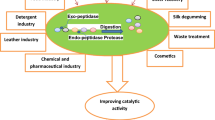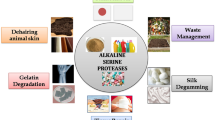Abstract
A gene encoding a novel extracellular subtilisin-like protease was cloned from the ascomycete Fusarium equiseti and expressed in Trichoderma reesei. The F. equiseti protease (Fe protease) showed excellent performance in stain removal and good compatibility with several commercial laundry detergent formulations, suggesting that it has high potential for use in various industrial applications. The recombinant enzyme was purified and characterized. The temperature optimum of the Fe protease was 60 °C and it showed high activity in the pH range of 6–10, with a sharp decline in activity at pH above 10. The amino acid specificity of the Fe protease was studied using casein, cytochrome c, and ubiquitin as substrates. The Fe protease had broad substrate specificity: almost all amino acid residues were accepted at position P1, even though it showed some preference for cleavage at the C-terminal side of asparagine and histidine residues. The S4 subsite of Fe protease favors aspartic acid and threonine. The other well-characterized proteases from filamentous fungi, Proteinase K from Engyodontium album, Thermomycolin from Malbranchea sulfurea, and alkaline subtilisins from Bacillus species prefer hydrophobic amino acids in both the S1 and S4 subsites. Due to its different specificity compared to the members of the S8 family of clan SB of proteases, we consider that the Fe protease is a new protease. It does not belong to any previously defined IUBMB groups of proteases.









Similar content being viewed by others
References
Craik, C. S., Page, M. J., & Madison, E. L. (2011). Proteases as therapeutics. The Biochemical Journal, 435(1), 1–16.
Gupta, R., Beg, Q. K., & Lorenz, P. (2002). Bacterial alkaline proteases: molecular approaches and industrial applications. Applied Microbiology and Biotechnology, 59, 15–32.
Singhal, P., Nigam, V. K., & Vidyarthi, A. S. (2012). Studies on production, characterization and applications of microbial alkaline proteases. International Journal of Advanced Biotechnology and Research, 3(3), 653–669.
Siezen, R. J., & Leunissen, J. A. (1997). Subtilases: the superfamily of subtilisin-like serine proteases. Protein Science, 6(3), 501–523.
Tomkinson, B. & Eklund, S. (2013). Tripeptidyl-peptidase II. In N. D. Rawlings, G. Salvesen (Eds.), Handbook of Proteolytic Enzymes. Volume 3. 3rd (pp. 3325–3331). Elsevier.
Maurer, K. H. (2004). Detergent proteases. Current Opinion in Biotechnology, 15(4), 330–334.
Betzel, C., Pal, G. P., & Saenger, W. (1988). Three-dimensional structure of proteinase K at 0.15-nm resolution. European Journal of Biochemistry, 178(1), 155–171.
Kraus, E., & Femfert, U. (1976). Proteinase K from the mold Tritirachium album Limber. Specificity and mode of action. Hoppe-Seyler’s Zeitschrift für physiologische Chemie, 357, 937–947.
Lizardi, P. M., & Engelberg, A. (1979). Rapid isolation of RNA using proteinase K and sodium perchlorate. Analytical Biochemistry, 98(1), 116–122.
Ebeling, W., Hennrich, N., Klockow, M., Metz, H., Orth, H. D., & Lang, H. (1974). Proteinase K from Tritirachium album Limber. European Journal of Biochemistry, 47, 91–97.
Guo, J.-P., & Ma, Y. (2008). High-level expression, purification and characterization of recombinant Aspergillus oryzae alkaline protease in Pichia pastoris. Protein Expression and Purification, 58(2), 301–308.
Ong, P. S., & Gaucher, G. M. (1976). Production, purification and characterization of thermomycolase, the extracellular serine protease of the thermophilic fungus Malbranchea pulchella var. sulfurea. Canadian Journal of Microbiology, 22(2), 165–176.
Stevenson, K. J., & Gaucher, G. M. (1975). The substrate specificity of thermomycolase, an extracellular serine proteinase from the thermophilic fungus Malbranchea pulchella var. sulfurea. The Biochemical Journal, 151(3), 527–542.
Liang, L., Meng, Z., Ye, F., Yang, J., Liu, S., Sun, Y., et al. (2010). The crystal structures of two cuticle-degrading proteases from nematophagous fungi and their contribution to infection against nematodes. FASEB Journal, 24(5), 1391–1400.
Pähler, A., Banerjee, A., Dattagupta, J. K., Fujiwara, T., Lindner, K., Pal, G. P., et al. (1984). Three-dimensional structure of fungal proteinase K reveals similarity to bacterial subtilisin. The EMBO Journal, 3(6), 1311–1314.
Siezen, R. J., Renckens, B., & Boekhorst, J. (2007). Evolution of prokaryotic subtilases: genome-wide analysis reveals novel subfamilies with different catalytic residues. Proteins: Structure, Function, and Bioinformatics, 67(3), 681–694.
Parry, D. W., Jenkinson, P., & McLeod, L. (1995). Fusarium ear blight (scab) in small grain cereals—a review. Plant Pathology, 44, 207–238.
Castro, I. M., Lima, A. A., Paula, C. A., Nicoli, J. R., & Brandão, R. L. (1991). Effect of substrate and pH on the activity of proteases from Fusarium oxysporum var. lini. Journal of Fermentation and Bioengineering, 72(2), 132–134.
Kumari, B. L., Vijetha, P., & Sudhakar, P. (2010). Optimization of physico-chemical properties for production of alkaline protease from Fusarium graminearum. Recent Research in Science and Technology, 2(4), 24–28.
Dunaevskii, Y. E., Matveeva, A. R., Fatkhullina, G. N., Belyakova, G. A., Kolomiets, T. M., Kovalenko, E. D., et al. (2008). Extracellular proteases of mycelial fungi as participants of pathogenic process. Russian Journal of Bioorganic Chemistry, 34(3), 286–289.
Pekkarinen, A. I., & Jones, B. L. (2002). Trypsin-like proteinase produced by Fusarium culmorum grown on grain proteins. Journal of Agricultural and Food Chemistry, 50(13), 3849–3855.
Choudhuri, S., DiNovi, M., Leblanc, J.-C., Meyland, I., Mueller, U., & Srinivasan, J. (2012). Serine protease (trypsin) from Fusarium oxysporum expressed in Fusarium venenatum. FAO JECFA Monographs, 13, 51–61.
Perona, J. J., & Craik, C. S. (1995). Structural basis of substrate specificity in the serine proteases. Protein Science, 4(3), 337–360.
Olivieri, F., Zanetti, M. E., Oliva, C. R., Covarrubias, A. A., & Casalongue, C. A. (2002). Characterization of an extracellular serine protease of Fusarium eumartii and its action on pathogenesis related proteins. European Journal of Plant Pathology, 108, 63–72.
Pekkarinen, A. I., Jones, B. L., & Niku-Paavola, M.-L. (2002). Purification and properties of an alkaline proteinase of Fusarium culmorum. European Journal of Biochemistry, 269, 798–807.
DelMar, E. G., Largman, C., Brodrick, J. W., & Geokas, M. C. (1979). A sensitive new substrate for chymotrypsin. Analytical Biochemistry, 99(2), 316–320.
Gasteiger, E., Gattiker, A., Hoogland, C., Ivanyl, I., Appel, R. D., & Balroch, A. (2003). ExPASy: the proteomics server for in-depth protein knowledge and analysis. Nucleic Acids Research, 31(13), 3784–3788.
Shevchenko, A., Wilm, M., Vorm, O., Jensen, O. N., Podtelejnikov, A. V., Neubauer, G., et al. (1996). A strategy for identifying gel-separated proteins in sequence databases by MS alone. Biochemical Society Transactions, 24(3), 893–896.
Poutanen, M., Salusjärvi, L., Ruohonen, L., Penttilä, M., & Kalkkinen, N. (2001). Use of matrix-assisted laser desorption/ionization time-of-flight mass mapping and nanospray liquid chromatography/electrospray ionization tandem mass spectrometry sequence tag analysis for high sensitivity identification of yeast proteins separated by two-dimensional gel electrophoresis. Rapid Communications in Mass Spectrometry, 15(18), 1685–1692.
Sambrook, J., & Russell, D. W. (2001). Molecular cloning. A laboratory manual (3rd ed., pp. 1–3). Cold Spring Harbor: Cold Spring Harbor Laboratory Press (CSHL Press).
Raeder, U., & Broda, P. (1985). Rapid preparation of DNA from filamentous fungi. Letters in Applied Microbiology, 1(1), 17–20.
Gurr, S. J., Unkles, S. E., & Kinghorn, J. R. (1987). The structure and organization of nuclear genes of filamentous fungi. In J. R. Kinghorn (Ed.), Gene structure in eukaryotic microbes (pp. 93–139). Washington: Special Publications of the Society for General Microbiology.
Bendtsen, J. D., Nielsen, H., von Heijne, G., & Brunak, S. (2004). Improved prediction of signal peptides: signalIP 3.0. Journal of Molecular Biology, 340(4), 783–795.
Paloheimo, M., Mäntylä, A., Kallio, J., & Suominen, P. (2003). High-yield production of a bacterial xylanase in the filamentous fungus Trichoderma reesei requires a carrier polypeptide with an intact domain structure. Applied and Environmental Microbiology, 69(12), 7073–7082.
Penttilä, M., Nevalainen, H., Rättö, M., Salminen, E., & Knowles, J. (1987). A versatile transformation system for the cellulolytic filamentous fungus Trichoderma reesei. Gene, 61(2), 155–164.
Karhunen, T., Mantyla, A., Nevalainen, K. M., & Suominen, P. L. (1993). High frequency one-step gene replacement in Trichoderma reesei. I. Endoglucanase I overproduction. Molecular and General Genetics MGG, 241(5–6), 515–522.
Joutsjoki, V. V., Torkkeli, T. K., & Nevalainen, K. M. (1993). Transformation of Trichoderma reesei with the Hormoconis resinae glucoamylase P (gamP) gene: production of a heterologous glucoamylase by Trichoderma reesei. Current Genetics, 24(3), 223–228.
Britton, H.T.S. & Robinson, R.A. (1931). CXCVIII: universal buffer solutions and the dissociation constant of veronal. Journal of the Chemical Society C: Organic, 1456–1462.
Davies, M. T. (1959). A universal buffer solution for use in ultra-violet spectrophotometry. Analyst, 84, 248–251.
Rawlings, N. D., Waller, M., Barrett, A. J., & Bateman, A. (2013). MEROPS: the database of proteolytic enzymes, their substrates and inhibitors. Nucleic Acids Research, 42(D1), D503.
Georgieva, D., Genov, N., Voelter, W., & Betzel, C. (2006). Catalytic efficiencies of alkaline proteinases from microorganisms. Zeitschrift für Naturforschung. C, 61(5–6), 445–452.
Taguchi, S., Ozaki, A., & Momose, H. (1998). Engineering of a cold-adapted protease by sequential random mutagenesis and a screening system. Applied and Environmental Microbiology, 64(2), 492–495.
Tindbaek, N., Svendsen, A., Oestergaard, P. R., & Draborg, H. (2004). Engineering a substrate-specific cold-adapted subtilisin. Protein Engineering Design and Selection, 17(2), 149–156.
Betzel, C., Klupsch, S., Branner, S., & Wilson, K. S. (1996). Crystal structures of the alkaline proteases savinase and esperase from Bacillus lentus. Advances in Experimental Medicine and Biology, 379, 49–61.
Horn, J. R., Ramaswamy, S., & Murphy, K. P. (2003). Structure and energetics of protein–protein interactions: the role of conformational heterogeneity in OMTKY3 binding to serine proteases. Journal of Molecular Biology, 331(2), 497–508.
Betzel, C., Gourinath, S., Kumar, P., Kaur, P., Perbandt, M., Eschenburg, S., et al. (2001). Structure of a serine protease Proteinase K from Tritirachium album limber at 0.98 Å resolution. Biochemistry, 40, 3080–3088.
Savitha, S., Sadhasivam, S., Swaminathan, K., & Lin, F. H. (2011). Fungal protease: production, purification and compatibility with laundry detergents and their wash performance. Journal of the Taiwan Institute of Chemical Engineers, 42(2), 298–304.
Cavello, I. A., Hours, R. A., & Cavalitto, S. F. (2012). Bioprocessing of “hair waste” by Paecilomyces lilacinus as a source of a bleach-stable, alkaline, and thermostable keratinase with potential application as a laundry detergent additive: characterization and wash performance analysis. Biotechnology Research International, 2012, 369308.
Niyonzima, F. N., & More, S. (2014). Purification and properties of detergent-compatible extracellular alkaline protease from Scopulariopsis spp. Preparative Biochemistry & Biotechnology, 44(7), 738–759.
Estell, D. A., Grayear, T. P., & Wells, J. A. (1985). Engineering an enzyme by site-directed mutagenesis to be resistant to chemical oxidation. The Journal of Biological Cehemistry, 260(11), 6518–6521.
Vojcic, L., Despotovic, D., Maurer, K.-H., Zacharias, M., Bocola, M., Martinez, R., et al. (2013). Reengineering of subtilisin Carlsberg for oxidative resistance. Biological Chemistry, 394(1), 79–87.
Grøn, H., Bech, L. M., Branner, S., & Breddam, K. (1990). A highly active and oxidation-resistant subtilisin-like enzyme produced by a combination of site-directed mutagenesis and chemical modification. European Journal of Biochemistry, 194(3), 897–901.
Acknowledgments
The authors wish to thank Gunilla Rönnholm of the Institute of Biotechnology in Helsinki for her contribution on determination of the peptide sequences. The authors are grateful to Karl-Heinz Maurer for critically reviewing the manuscript.
Author information
Authors and Affiliations
Corresponding author
Rights and permissions
About this article
Cite this article
Juntunen, K., Mäkinen, S., Isoniemi, S. et al. A New Subtilase-Like Protease Deriving from Fusarium equiseti with High Potential for Industrial Applications. Appl Biochem Biotechnol 177, 407–430 (2015). https://doi.org/10.1007/s12010-015-1752-6
Received:
Accepted:
Published:
Issue Date:
DOI: https://doi.org/10.1007/s12010-015-1752-6




